The ASRock X99E-ITX/ac Review: Up to 36 Threads in Mini-ITX
by Ian Cutress on June 24, 2015 8:00 AM ESTGaming Performance 2015
Our 2015 gaming results are still relatively new, and thus along with the motherboards tested we are also including some other CPU results for completeness.
Alien: Isolation
If first person survival mixed with horror is your sort of thing, then Alien: Isolation, based off of the Alien franchise, should be an interesting title. Developed by The Creative Assembly and released in October 2014, Alien: Isolation has won numerous awards from Game Of The Year to several top 10s/25s and Best Horror titles, ratcheting up over a million sales by February 2015. Alien: Isolation uses a custom built engine which includes dynamic sound effects and should be fully multi-core enabled.
For low end graphics, we test at 720p with Ultra settings, whereas for mid and high range graphics we bump this up to 1080p, taking the average frame rate as our marker with a scripted version of the built-in benchmark.


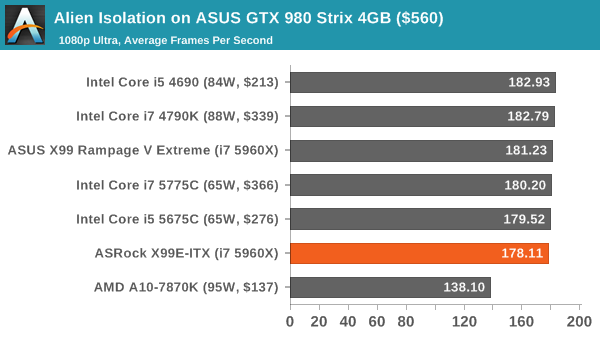
Total War: Attila
The Total War franchise moves on to Attila, another The Creative Assembly development, and is a stand-alone strategy title set in 395AD where the main story line lets the gamer take control of the leader of the Huns in order to conquer parts of the world. Graphically the game can render hundreds/thousands of units on screen at once, all with their individual actions and can put some of the big cards to task.
For low end graphics, we test at 720p with performance settings, recording the average frame rate. With mid and high range graphics, we test at 1080p with the quality setting. In both circumstances, unlimited video memory is enabled and the in-game scripted benchmark is used.
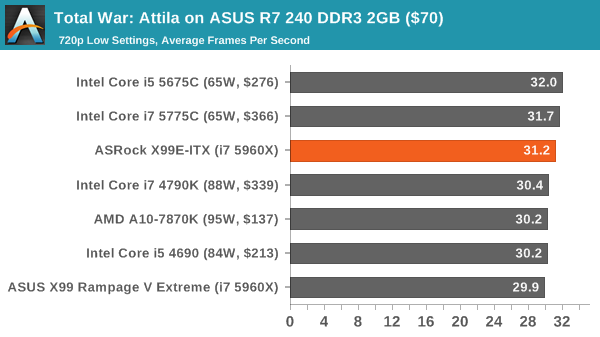
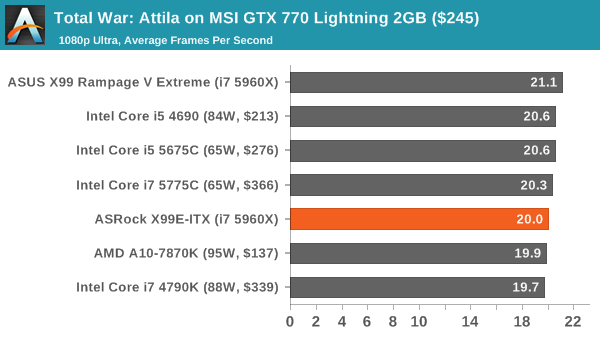
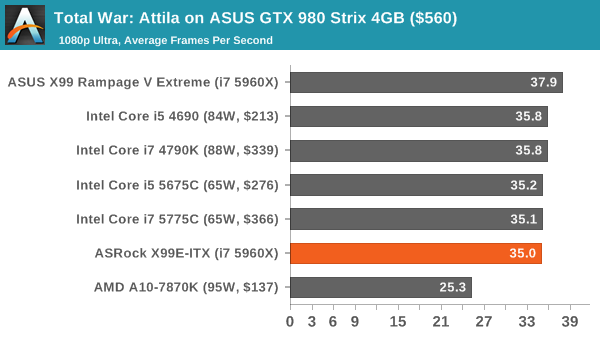
Grand Theft Auto V
The highly anticipated iteration of the Grand Theft Auto franchise finally hit the shelves on April 14th 2015, with both AMD and NVIDIA in tow to help optimize the title. GTA doesn’t provide graphical presets, but opens up the options to users and extends the boundaries by pushing even the hardest systems to the limit using Rockstar’s Advanced Game Engine. Whether the user is flying high in the mountains with long draw distances or dealing with assorted trash in the city, when cranked up to maximum it creates stunning visuals but hard work for both the CPU and the GPU.
For our test we have scripted a version of the in-game benchmark, relying only on the final part which combines a flight scene along with an in-city drive-by followed by a tanker explosion. For low end systems we test at 720p on the lowest settings, whereas mid and high end graphics play at 1080p with very high settings across the board. We record both the average frame rate and the percentage of frames under 60 FPS (16.6ms).
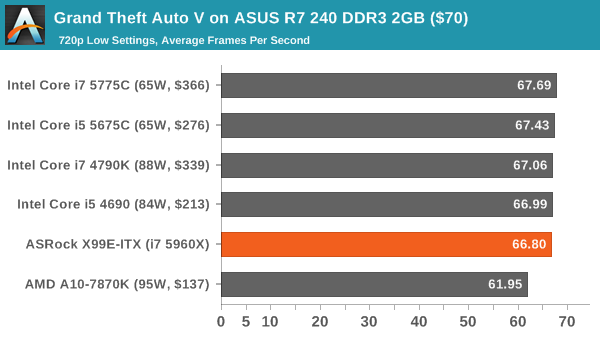
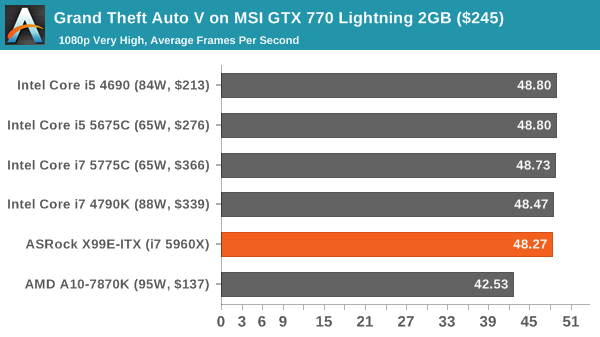
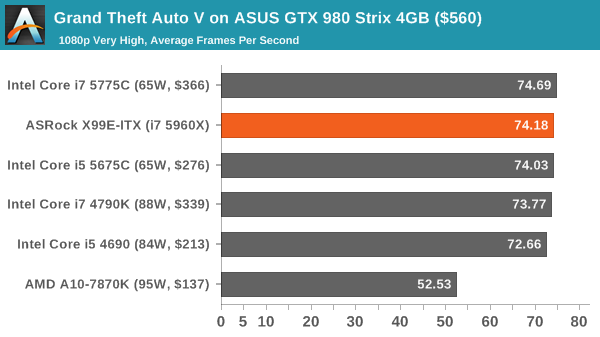
GRID: Autosport
No graphics tests are complete without some input from Codemasters and the EGO engine, which means for this round of testing we point towards GRID: Autosport, the next iteration in the GRID and racing genre. As with our previous racing testing, each update to the engine aims to add in effects, reflections, detail and realism, with Codemasters making ‘authenticity’ a main focal point for this version.
GRID’s benchmark mode is very flexible, and as a result we created a test race using a shortened version of the Red Bull Ring with twelve cars doing two laps. The car is focus starts last and is quite fast, but usually finishes second or third. For low end graphics we test at 1080p medium settings, whereas mid and high end graphics get the full 1080p maximum. Both the average and minimum frame rates are recorded.
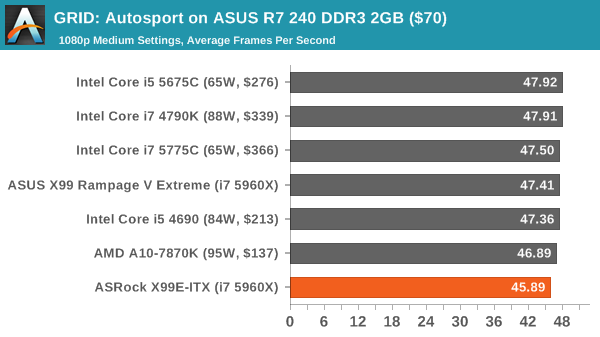
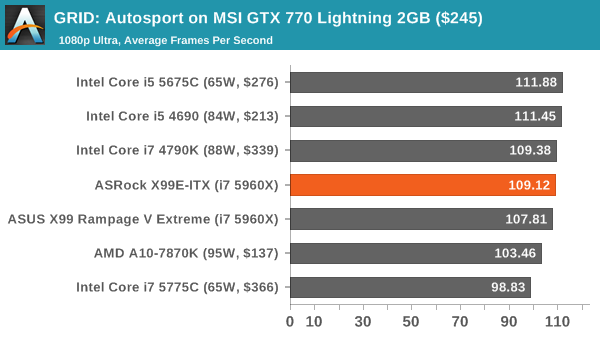
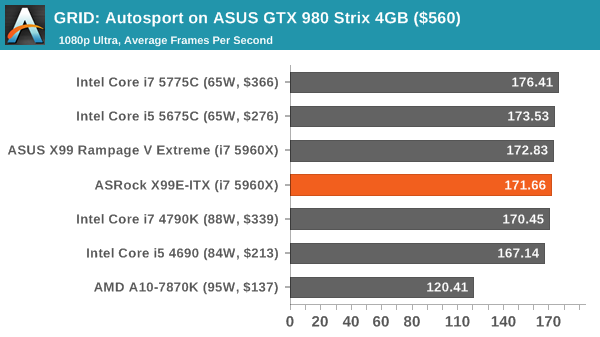
Middle-Earth: Shadows of Mordor
The final title in our testing is another battle of system performance with the open world action-adventure title, Shadows of Mordor. Produced by Monolith using the LithTech Jupiter EX engine and numerous detail add-ons, SoM goes for detail and complexity to a large extent, despite having to be cut down from the original plans. The main story itself was written by the same writer as Red Dead Redemption, and it received Zero Punctuation’s Game of The Year in 2014.
For testing purposes, SoM gives a dynamic screen resolution setting, allowing us to render at high resolutions that are then scaled down to the monitor. As a result, we get several tests using the in-game benchmark. For low end graphics we examine at 720p with low settings, whereas mid and high end graphics get 1080p Ultra. The top graphics test is also redone at 3840x2160, also with Ultra settings, and we also test two cards at 4K where possible.
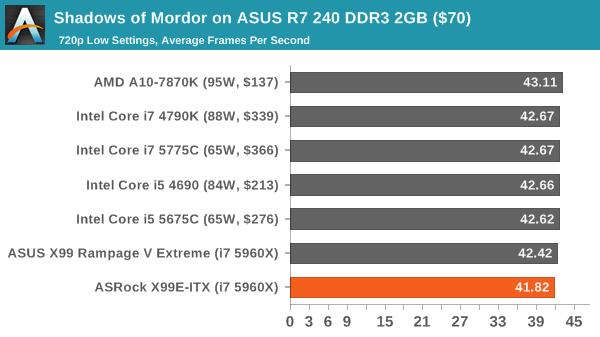
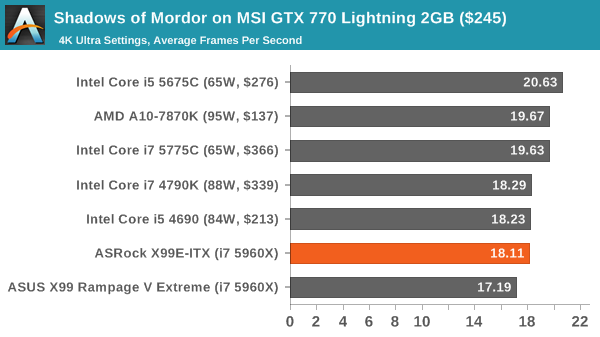
















56 Comments
View All Comments
leexgx - Wednesday, June 24, 2015 - link
needs to be DDR4 ECC RDIMM (registered but not buffered) not buffered or Chipkill (the link you posted seems buffered or a chipkill like ram)bebimbap - Wednesday, June 24, 2015 - link
I remember on one of the asrock boards, the z97e itx ac, had its M.2 on the back of the motherboard.With a x99 platform, if you save 16 for the cpu you have at least 12 lanes to work with, so reasonably you could add 3 M.2 slots on the back, or 6 M.2 slots each with pcie3.0-4x.
I understand there is probably a Z height restriction on the back of the board, and probably costs, since you have to plan 2 sides of the board, routing, flexing, etc. However I believe if a M.2 slot can fit, i'm sure most of the transistors and chips such as the sound, LAN, a lot of resistors, wifi, maybe another 2 slots of memory on the back, or all 4, flat of course, and maybe even the PCH with a revised heatsink of course can fit. If more items were on the back of the board, you could fit the CPU socket closer to the pcie slot and allow for all 4 channels of memory. It would be a monster of a rig. 4 channels of ddr4 + 3-6 M.2 pcie3.0x4 in raid0 + pcie3.0x16
Though it might be $400+, I'm sure there would be some interest a fractional proportion to the all out x99 extreme11 series. It would certainly interest me.
WithoutWeakness - Wednesday, June 24, 2015 - link
I love this board. I've had it for a little over a month now running my Plex server/NAS. I had an i5-4440 on an mITX Gigabyte board but it could only handle ~3 1080p transcodes before it started to struggle. Once ASRock released this board I grabbed it and tossed a i7-5820K in and now it has no issues transcoding 6+ streams. I haven't even gotten around to overclocking the 5820K yet.Absolutely amazing how they managed to cram that socket and the powerful VRM solution on this board and still have enough space to fit things like the M.2 slot. ASRock has some impressive engineers on staff. For my use case I needed as many cores as possible in the smallest space as I had already invested in my Node 304 and really didn't want to move to another case. I did need to buy an SFX power supply as I was concerned about my ATX power supply blocking the right-angle SATA ports but that specific issue is due to the layout of the Node 304.
DCide - Wednesday, June 24, 2015 - link
If it's like their mATX board, just start with the slowest (4GHz) OC pre-set in the BIOS. It runs very stably for me.You can fine tune it later if you want to, but in the meantime you can get significant performance benefits right away.
Samus - Thursday, June 25, 2015 - link
I can't wait to get mine. Just ordered it after reading this review, which provided proof of what I suspected all along...quad-channel doesn't provide much in the way of general performance, just like triple-channel didn't provide much performance on X58.Of all the things dual-channel will bottle-neck, the only program I use that would be affected is WinRAR and that's negligible.
ASRock gets a LOT of street cred for making such a bold product. This is the kind of thing DFI or ABIT would have made if they were still around. An ultra-enthusiast, niche, and risky product. It's possible they won't even break even on this considering the amount of engineering that went into it. Margins are already razor thin on motherboards so they need to sell tens of thousands of these to make any money, even at $250 a pop.
BubbaJoe TBoneMalone - Wednesday, June 24, 2015 - link
I'm surprised the other manufacturers are not giving ASRock any competition with their own X99 Mini-ITX motherboard.T1beriu - Wednesday, June 24, 2015 - link
Where's your Fury X review?! :(Where's your Radeon 300 series review?
Have you lost your contacts with AMD PR or lack of time?
Ian Cutress - Wednesday, June 24, 2015 - link
Check the first sentence of the review.just4U - Wednesday, June 24, 2015 - link
Is that something he's been battling for a bit now? We had this flu going around in Canada this past winter that easily throws you for a loop for 3 weeks.. just as you start to think your getting better it knocks you on your ass even worse. Nasty little virus.heh.. he's going to be a busy little beaver.. He mentioned something about the 960 review coming up this week as well.
Samus - Thursday, June 25, 2015 - link
When I get sick, I get sick for weeks, too. Fortunately it's only once a year for me.